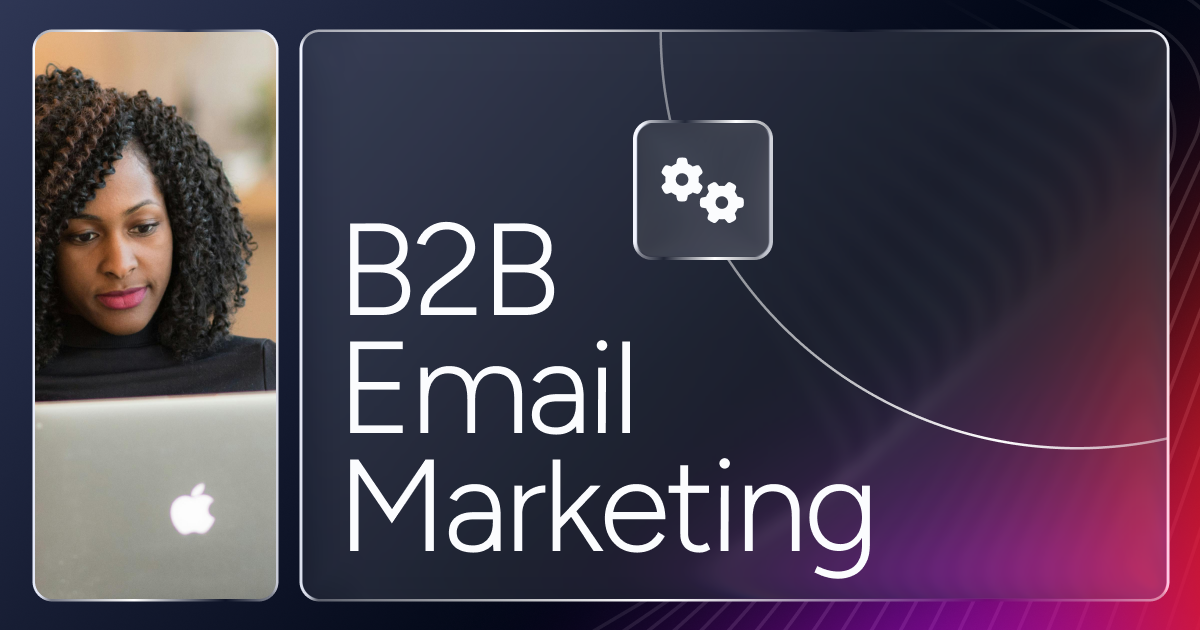B2B email still outperforms every other digital channel, but only when it’s executed with precision.
Effective programs tie each send to a real buyer question and build on clean, compliant data so automation, segmentation, and reporting all work as intended.
B2B email marketing best practices include personalizing content beyond just the name, using value-driven subject lines that are concise and compelling, and segmenting your audience based on business-oriented criteria. Other key practices are focusing on clear, scannable content in the email body, crafting action-oriented calls to action (CTAs), and continually testing and analyzing campaign performance. These B2B email marketing best practices reflect the plays GTM teams are running right now to drive measurable outcomes.
Why B2B Email Marketing Keeps Outperforming
As paid channels grow more expensive and attribution harder to trust, B2B teams are turning back to what they can control: the inbox. Email continues to outperform because teams can control timing, data quality, and segmentation in ways paid channels can’t.
Most failures happen when teams optimize for clicks instead of what buyers actually need. Gartner found that when personalization is off-target, more than half of customers report a negative experience and are 3.2 times more likely to regret their purchase. Relevance drives performance because it aligns to how buyers evaluate solutions.
Clean data is what makes that relevance possible. Companies lose as much as 25% of potential revenue to dirty or incomplete records, a reminder of how much impact data quality shapes personalization and email performance. When Sendoso enriched its database with ZoomInfo, the team cut inaccurate data by 70%, saved more than 1,100 hours of manual work, reached 10% more ICP contacts, and created more than $4.9M in new pipeline in two quarters. Accurate data removes friction and lets targeting do its job.
Effective B2B email programs stay relevant by matching timing to intent and improving with every send. That discipline turns consistency into performance.
B2B Email Marketing Workflow Best Practices
The highest-performing B2B email programs stay consistent over time rather than layering on complexity for its own sake. These practices keep teams focused on what drives engagement and pipeline.
Protect deliverability with clean, compliant data
The path to stronger deliverability starts with accurate data and clear consent.
Identify your sender clearly in every email and include a visible unsubscribe option to comply with CAN-SPAM (U.S.)
Capture and document consent under CASL (Canada’s Anti-Spam Legislation) and GDPR (General Data Protection Regulation) to ensure verifiable opt-ins
Validate and enrich contact records quarterly to prevent data decay and maintain accurate segmentation
Align messaging by ICP and lifecycle stage
Accurate segmentation keeps messaging relevant and performance steady across the buyer journey.
Use enrichment tools to fill firmographic and title gaps so targeting stays accurate as data changes
Base personalization on clear buying signals, not job titles or vanity fields
Segment by ICP, lifecycle stage, and behavior so each message meets the buyer where they are in the process
Clean, accurate data makes it possible to build targeted email lists that reflect real buyer attributes and intent.
Automate lifecycle campaigns to drive performance
Automation ensures every touch lands when buyers are most likely to act and lets your team spend time on strategy instead of sends.
Build automated workflows for onboarding, nurture, event follow-up, and renewal to ensure every stage gets a timely, data-backed touch
Align triggers with live buyer signals such as product use, engagement scores, and contract milestones to keep timing accurate and relevant
Review workflows quarterly to update content, adjust cadence, and sustain engagement over time
Keep every B2B email centered on one clear offer
Testing across nurture and outbound sequences shows emails perform best when they center on one outcome and offer a clear next step. This gives the reader one reason, and one way, to act.
Write around one outcome buyers care about and make it obvious why it matters
Give every send a single next step such as a demo, a download, or a reply to keep intent clear
Keep copy and design simple so attention stays on the call to action
“Act on buying signals from your top accounts” will earn more clicks than “Learn how we identify intent.” A data-driven offer such as “Reach verified decision-makers in minutes” will consistently outperform broad claims like “Find better prospects.”
Measure performance that drives decisions
Metrics only matter if they show how emails influence real outcomes. Effective teams use data to guide the next send, not to celebrate the last one.
Track engagement quality with click-to-open rate and click-through rate, not just volume
Connect conversions to downstream actions such as demos, downloads, or meetings to see which emails create real pipeline impact
Use industry benchmarks for context but set goals based on your own historical performance
Accurate measurement depends on clean inputs, and enrichment keeps your data current and compliant so results stay reliable. Optimization only matters when it sharpens timing or targeting, and the lift shows up in the next few sends.
Use Data Enrichment to Power Smarter B2B Email Marketing
Data enrichment turns static lists into living systems. When contact, company, and intent data stay current, every send reflects the buyer’s real context. In ZoomInfo’s Customer Impact Report, sales teams using enriched data saw connect rates jump from 23% to 44%, a 91% lift that came directly from better targeting.
Use enrichment to keep targeting fields such as industry, role, and company size accurate as buyer data changes
Sync enrichment data with automation platforms so segmentation and scoring update in real time
Refresh enrichment regularly to prevent decay and reduce wasted sends to bad contacts
Examples of B2B Email Programs That Drive Engagement
These programs show how top teams use email to guide buyers from first touch to renewal.
Welcome / new lead series
Deliver the promised content immediately and set communication preferences
Follow up within a few days with content tied to the buyer’s industry or pain point to reinforce credibility early
Close with a role-based CTA that moves the buyer to the next logical step
Webinar lifecycle
Send the invite with a concise value statement and an add-to-calendar link so registration turns into attendance
Schedule reminders in each recipient’s local time, usually 24 hours and again one hour before the session, to maximize live attendance
Send a replay after the event with a next step that fits each attendee’s role or engagement level
Re-engagement campaigns
Validate contact data and confirm consent before restarting outreach
Lead with value and transparency to show what subscribers gain by staying on your list
Offer a simple way to stay subscribed or update preferences
Execution matters, but the message is what earns the click. Design and copy are where timing turns into action.
B2B Email Design and Copy That Drive Action
Subject lines should highlight an outcome the reader cares about, not a product feature
Example: “Reach verified buyers in half the time.”
Keep the body tight and scannable, building around one story and one clear CTA
Use enriched fields like industry, company size, or region to make content relevant without forcing personalization
Protect Deliverability Through B2B Email Compliance
Compliance protects deliverability and buyer trust when it’s built into every send rather than applied after something breaks. Accurate consent records keep send lists current and compliant. When compliance and data hygiene align, deliverability improves because mailbox providers see consistent, compliant activity.
Identify the sender clearly, include a postal address, and honor unsubscribe requests within 10 business days (CAN-SPAM, U.S.)
Collect express or implied consent, identify the sender, and keep records of consent to stay compliant (CASL, Canada)
Ensure every contact has a lawful basis under GDPR or PECR, following ICO guidance on consent and opt-outs (U.K.)
Embedding compliance into your data workflows protects sender reputation and keeps campaigns performing predictably.
Measure B2B Email Performance That Drives Decisions
Benchmarks give you context, but decisions should come from patterns in your own data. They matter most when they drive the next decision, not when they just validate what’s already been done.
To use benchmarks the way effective B2B teams do:
Track performance across core programs like onboarding, nurture, and renewal so you can see how engagement builds through the customer journey
Use industry or audience-size reports for direction, but verify those patterns in your own data before changing anything
Focus on metrics that connect to conversions and pipeline because vanity numbers hide real performance
Test one variable at a time to isolate what drives improvement and keep those learnings repeatable
The Bottom Line for B2B Email Marketing
Effective B2B email programs stay sharp by treating every send as a chance to learn. When timing reflects real intent and data stays accurate, email earns attention when timing and targeting stay accurate. The teams that keep improving a little at a time build programs that last.


